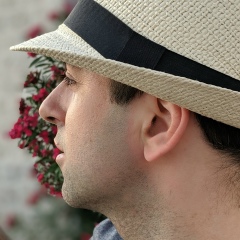Scelsi's most famous work is the Quattro Pezzi su una nota sola for chamber orchestra of twenty-six musicians. Unusually for Scelsi's orchestral music, this composition was performed shortly after it was written: in Paris under Maurice Leroux on December 4th, 1961. It gave the composer some amount of recognition at the time, and is now known as one of the most pioneering works of the 20th century: each piece sticks rigorously to a single note, the succession being: F, B, Ab, A.
-
https://youtu.be/MfTjz6emd7c
-
As is normal in Scelsi's orchestral music, the instruments are concentrated in the low registers and include percussion: alto flute, oboe, English horn, two clarinets, bass clarinet, bassoon, four horns, saxophone, three trumpets, two trombones, bass tuba, musical saw, timpani, bongos, tumba, suspended cymbal, small and large tamtam, two violas, two cellos, double bass. The four movements use slightly different forces, and only the last combines all twenty-six musicians. The pieces each elaborate their single notes by means of variations in tessitura (unisons and octave doublings), dynamics and timbre, as well as introducing microtonal fluctuations and the occasional harmonic shadow; climaxes appear in these various domains at different times, all formally derived from the golden ratio.
-
The brief the first movement presents the melodic material - and it is indeed melodic, due to shading, rhythm and instrumental timbre - in an eruption of incredible power; one could not imagine a more effective introduction to this piece or to Scelsi's mature music in general. After the high drama of the second movement, the third (omitting percussion) has an ethereal quality about it which hangs beyond time in the slowly decaying sound of its final moments. The fourth movement has an extreme finality, with cadences punctuated by percussive outbursts, as if to say: I am sound (by Todd McComb)
-
https://youtu.be/MfTjz6emd7c
-
As is normal in Scelsi's orchestral music, the instruments are concentrated in the low registers and include percussion: alto flute, oboe, English horn, two clarinets, bass clarinet, bassoon, four horns, saxophone, three trumpets, two trombones, bass tuba, musical saw, timpani, bongos, tumba, suspended cymbal, small and large tamtam, two violas, two cellos, double bass. The four movements use slightly different forces, and only the last combines all twenty-six musicians. The pieces each elaborate their single notes by means of variations in tessitura (unisons and octave doublings), dynamics and timbre, as well as introducing microtonal fluctuations and the occasional harmonic shadow; climaxes appear in these various domains at different times, all formally derived from the golden ratio.
-
The brief the first movement presents the melodic material - and it is indeed melodic, due to shading, rhythm and instrumental timbre - in an eruption of incredible power; one could not imagine a more effective introduction to this piece or to Scelsi's mature music in general. After the high drama of the second movement, the third (omitting percussion) has an ethereal quality about it which hangs beyond time in the slowly decaying sound of its final moments. The fourth movement has an extreme finality, with cadences punctuated by percussive outbursts, as if to say: I am sound (by Todd McComb)
0
У записи 3 лайков,
0 репостов,
362 просмотров.
0 репостов,
362 просмотров.
Эту запись оставил(а) на своей стене Алексей Дурнев























